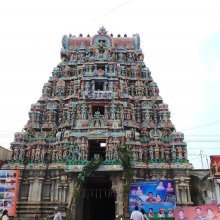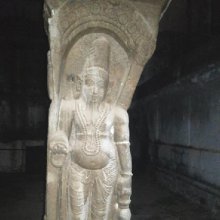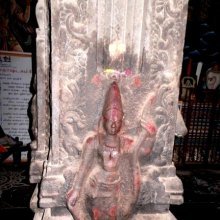Ramasvamin, Rāmasvāmin, Ramasvami, Rama-svamin, Rāmasvāmī: 6 definitions
Introduction:
Ramasvamin means something in Hinduism, Sanskrit, the history of ancient India. If you want to know the exact meaning, history, etymology or English translation of this term then check out the descriptions on this page. Add your comment or reference to a book if you want to contribute to this summary article.
Images (photo gallery)
India history and geography
Source: archive.org: Personal and geographical names in the Gupta inscriptionsRāmasvāmin (रामस्वामिन्) is an example of a name based on Rāma mentioned in the Gupta inscriptions. Lord Rāma is believed to be the seventh incarnation of Viṣṇu. Rāma occurring in our inscriptions seems to have been Rāma Rāghava. The Gupta empire (r. 3rd-century CE), founded by Śrī Gupta, covered much of ancient India and embraced the Dharmic religions such as Hinduism, Buddhism and Jainism. Derivation of personal names (e.g., Rāmasvāmin) during the rule of the Guptas followed patterns such as tribes, places, rivers and mountains.
Source: Shodhganga: The significance of the mūla-beras (history)Rāmasvāmī is another name for the Ramaswamy Temple in Kumbakonam (Kumbhakonam) which represents a sacred place for the worship of Viṣṇu.—The Ramaswamy (Rāmasvāmī) Temple in Kumbhakonam is renovated by Govinda Dikshita, a minister of the Nayaks of Tanjore. [According to the] sthala-purāṇa, the Ramaswamy (Rāmasvāmī) Temple was the place where Viṣṇu, as Sāraṅgapāṇi, married Goddess Lakṣmī as Kōmal a Valli. Therefore, this place is also called Kalyāṇapuram. As Sūrya Deva worshipped in this sthala, this place is also called Bāskara Kṣetra. Scenes from the Ramayana are painted in glowing colours on the walls of the prahāras.

The history of India traces the identification of countries, villages, towns and other regions of India, as well as mythology, zoology, royal dynasties, rulers, tribes, local festivities and traditions and regional languages. Ancient India enjoyed religious freedom and encourages the path of Dharma, a concept common to Buddhism, Hinduism, and Jainism.
Languages of India and abroad
Sanskrit dictionary
Source: Cologne Digital Sanskrit Dictionaries: Aufrecht Catalogus Catalogorum1) Rāmasvāmin (रामस्वामिन्) as mentioned in Aufrecht’s Catalogus Catalogorum:—Quoted in Mādhavīyadhātuvṛtti.
2) Rāmasvāmin (रामस्वामिन्):—Amarakośaṭīkā.
Source: Cologne Digital Sanskrit Dictionaries: Monier-Williams Sanskrit-English Dictionary1) Rāmasvāmin (रामस्वामिन्):—[=rāma-svāmin] [from rāma] m. Name of a statue of Rāma, [Rājataraṅgiṇī]
2) [v.s. ...] of various authors, [cf. Lexicographers, esp. such as amarasiṃha, halāyudha, hemacandra, etc.]
[Sanskrit to German]
Sanskrit, also spelled संस्कृतम् (saṃskṛtam), is an ancient language of India commonly seen as the grandmother of the Indo-European language family (even English!). Closely allied with Prakrit and Pali, Sanskrit is more exhaustive in both grammar and terms and has the most extensive collection of literature in the world, greatly surpassing its sister-languages Greek and Latin.
See also (Relevant definitions)
Partial matches: Rama, Svamin.
Starts with: Ramasvamipandita.
Ends with: Icharamasvamin.
Full-text: Ramaswamy, Ramavatara, Apyayadikshita, Trikanda, Namalinganushasana, Amarakosha.
Relevant text
Search found 8 books and stories containing Ramasvamin, Rāmasvāmin, Ramasvami, Rama-svamin, Rāma-svāmin, Rāmasvāmī, Rāma-svāmī; (plurals include: Ramasvamins, Rāmasvāmins, Ramasvamis, svamins, svāmins, Rāmasvāmīs, svāmīs). You can also click to the full overview containing English textual excerpts. Below are direct links for the most relevant articles:
Middle Chola Temples (by S. R. Balasubrahmanyam)
Temples in Seramadevi < [Chapter II - Temples of Rajaraja I’s Time]
Temples in Ennayiram < [Chapter II - Temples of Rajaraja I’s Time]
Sanskrit sources of Kerala history (by Suma Parappattoli)
15. Vrttaratnavali by Ilathur Ramaswami Sastri < [Chapter 6 - Miscellaneous Sanskrit works bearing on Kerala history]
15. Other Mahakavyas describing Kerala < [Chapter 3 - Historical Details from Mahakavyas]
15. Short Poems describing Kerala history < [Chapter 4 - Traces of Historical Facts from Sandesha Kavyas and Short poems]
Later Chola Temples (by S. R. Balasubrahmanyam)
Temples in Pattisvaram (Palayarai-Malapadi) < [Chapter X - Temples of Rajadhjraja II’s Time]
Trishashti Shalaka Purusha Caritra (by Helen M. Johnson)
Amarakoshodghatana of Kshirasvamin (study) (by A. Yamuna Devi)
Commentaries on Amarakośa < [Chapter 1 - Kośa Literature–A Brief Survey]



